| Reichskriegsgericht | |
|---|---|
 Former Reichskriegsgericht building on Witzlebenplatz | |
| Established | 1 October 1900 |
The Reichskriegsgericht (RKG; English: Reich Court-Martial) was the highest military court in Germany between 1900 and 1945.
| Reichskriegsgericht | |
|---|---|
 Former Reichskriegsgericht building on Witzlebenplatz | |
| Established | 1 October 1900 |
The Reichskriegsgericht (RKG; English: Reich Court-Martial) was the highest military court in Germany between 1900 and 1945.

After the Prussian-led Unification of Germany, the German Empire with effect from 1 October 1900 had established a particular court-martial jurisdiction (German : Militärgerichtsbarkeit) to try soldiers of the German Army, with the Reichsmilitärgericht (RMG) as the supreme court. The presiding judge in the rank of a general or admiral was appointed directly by the German Emperor. From 1910, the court had its seat in a newly erected prestigious building in Charlottenburg. During World War I, German military law enabled military courts to try not only soldiers but also civilians held to have violated the military law. In the post-war Weimar Republic (1919-1933), the separate jurisdiction for military personnel was abolished by the law of 17 August 1920, based on Article 106 of the Weimar Constitution.
After the Nazi seizure of power in 1933, courts-martial were reinstated by law of May 12, with effect from 1 January 1934. During the German re-armament and the deployment of the Wehrmacht armed forces, the Reichskriegsgericht was re-established as supreme court on 1 October 1936. According to the Wartime Criminal Code of Procedure (Kriegsstrafverfahrensordnung, KStVO) enacted by German Fuhrer Adolf Hitler and Field Marshal Wilhelm Keitel on 17 August 1938, the RKG had jurisdictional competence over acts of high treason, treason, and aiding the enemy (Kriegsverrat); if the defendant was not directly liable to prosecution by his commander-in-chief. The court also had sole responsibility for all legal proceedings against highest-ranking Wehrmacht officers.

For all severe cases of Wehrkraftzersetzung ("undermining military force") according to Wartime Special Penal Code (Kriegssonderstrafrechtsverordnung, KSSVO), the RKG was the first and last instance. By this accusation, the court sentenced numerous conscientious objectors to death. By ordinance of 18 May 1940, proceedings against civilians were handed over to Sondergericht courts; from 29 January 1943, the "People's Court" (Volksgerichtshof) had exclusive jurisdiction over all accusations of public Wehrkraftzersetzung and intentionally evading military service.
The President of the Reichskriegsgericht was able to affirm or to set aside a judgement; as was Hitler in his capacity as commander-in-chief of the Wehrmacht.
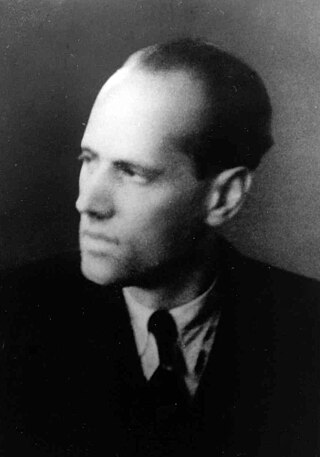
Helmuth James Graf von Moltke was a German jurist who, as a draftee in the German Abwehr, acted to subvert German human-rights abuses of people in territories occupied by Germany during World War II. He was a founding member of the Kreisau Circle opposition group, whose members opposed the government of Adolf Hitler in Nazi Germany, and discussed prospects for a Germany based on moral and democratic principles after Hitler. The Nazis executed him for treason for his participation in these discussions.

Operation Valkyrie was a German World War II emergency continuity of government operations plan issued to the Territorial Reserve Army of Germany to execute and implement in the event of a general breakdown in civil order of the nation. Failure of the government to maintain control of civil affairs might have been caused by the Allied bombing of German cities, or uprising of the millions of foreign forced labourers working in German factories.
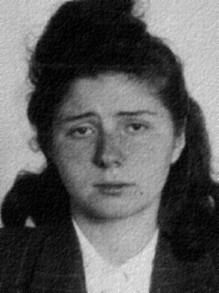
Liane Berkowitz was a German resistance fighter and was most notable for being a member of the Berlin-based pro-Soviet resistance group that coalesced around Harro Schulze-Boysen, that was later called the Red Orchestra by the Abwehr. Arrested and sentenced to death, she was executed shortly after she gave birth to a daughter in custody.

Cato Bontjes van Beek was a German member of the Resistance against the Nazi regime.
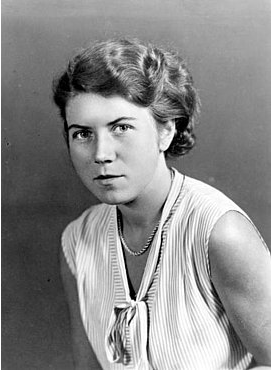
Maria "Mimi" Terwiel was a German resistance fighter against the Nazi regime. She was active in a group in Berlin that wrote and distributed anti-Nazi and anti-war appeals. As part of what they conceived as a broader action against a collection of anti-fascist resistance groups in Germany and occupied Europe that the Abwehr called the Red Orchestra, in September 1942 the Gestapo arrested Terwiel along with her fiancée Helmut Himpel. Among the leaflets and pamphlets they had copied and distributed for the group were the July and August 1941 sermons of Clemens August Graf von Galen which denounced the regime's Aktion T4 programme of involuntary euthanasia.
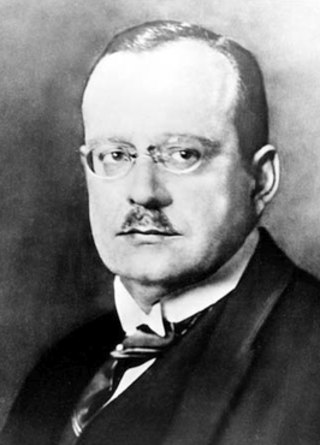
Paul Adolf Franz Lejeune-Jung, was a German economist, politician, lawyer in the wood pulp industry, and resistance fighter against Adolf Hitler's Third Reich.
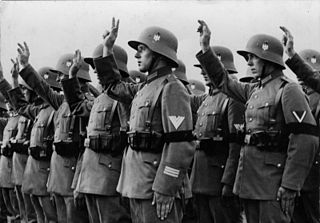
The Hitler Oath —also referred in English as the Soldier's Oath—refers to the oaths of allegiance sworn by the officers and soldiers of the German Armed Forces and civil servants of Nazi Germany between the years 1934 and 1945. The oath pledged personal loyalty to Adolf Hitler in place of loyalty to the constitution of the country. Historians view the personal oath of the Third Reich as an important psychological element to obey orders for committing war crimes, atrocities, and genocide. During the Nuremberg trials, many German officers unsuccessfully attempted to use the oath as a defense against charges of war crimes and crimes against humanity.
Capital punishment in Germany has been abolished for all crimes, and is now explicitly prohibited by constitution. It was abolished in West Germany in 1949, in the Saarland in 1956, and East Germany in 1987. The last person executed in Germany was the East German Werner Teske, who was executed at Leipzig Prison in 1981.

German military law has a long history.
Colonel Georg Alexander Hansen was an Oberst (Colonel) in the Generalstab and one of the participants in the German Resistance against the Nazi Regime of Adolf Hitler.
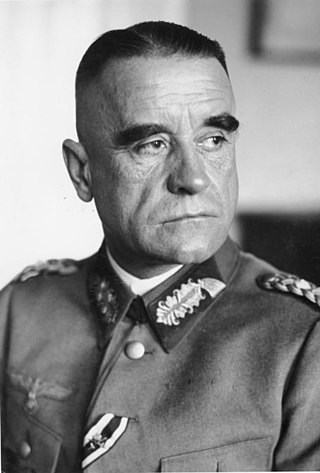
Walter Heitz was a German general (Generaloberst) in the Wehrmacht during World War II who served as President of the Reich Military Court and commanded part of the 6th Army in the Battle of Stalingrad.
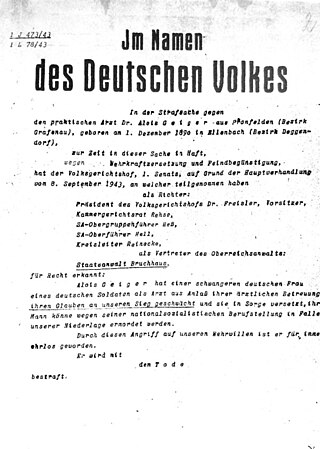
Wehrkraftzersetzung or Zersetzung der Wehrkraft was a sedition offence in German military law during the Nazi Germany era from 1938 to 1945.

Günther Weisenborn was a German writer and fighter in the German Resistance against Nazism. He was notable for collaborating with Bertolt Brecht, along with Hanns Eisler, Slatan Dudow, on the play, The Mother. However, in 1933, when the work fell out of favour by the Nazis after being blacklisted by Joseph Goebbels, he emigrated to Argentina. When he returned in 1937, be became a member of a Berlin-based, resistance group that was later renamed to the Red Orchestra by the Abwehr. He was arrested in 1942 and sentenced to several years in prison, he was released in 1945 by Soviet troops.
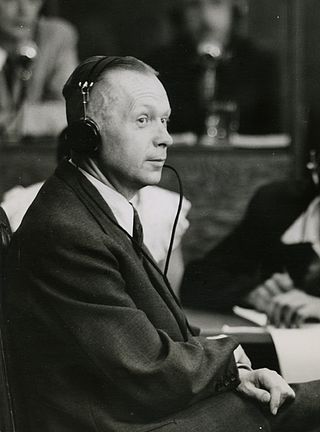
Manfred Roeder was a military judge in Nazi Germany. Serving on the highest wartime court, he led the investigation and examinations and later the prosecution of the German Resistance group, the Red Orchestra. He shared responsibility for the dozens of death sentences handed down by the Reich court martial to Red Orchestra members. After Germany's defeat in World War II, there were attempts by survivors, family and the U.S. Army to investigate the prosecutions of Red Orchestra members and others, but Roeder was never convicted of any malfeasance or crime because the Allies thought it more expedient to use his 'expertise' to hunt down the Red Orchestra members a second time than to mete out justice for victims of the Nazis; this time to aid the Western Allies with information about the Russians in the nascent cold war.
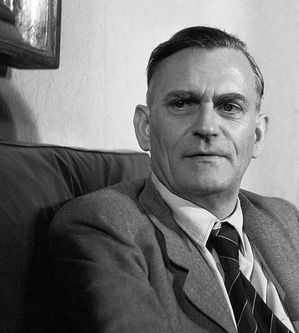
Adolf Berthold Ludwig Grimme was a German politician, a member of the Social Democratic Party (SPD). He was Cultural Minister during the later years of the Weimar Republic and after World War II, during the early years of the Federal Republic of Germany. During the Third Reich, he was arrested as a member of the German Resistance and sentenced to prison. After the war, he filed a legal complaint against the judge who had condemned him and others. After years of delays, the case was dropped by the prosecutor.

Wolfgang Kreher Johannes "John" Graudenz was a German journalist, press photographer, industrial representative and resistance fighter against the Nazi regime. Graudenz was most notable for being an important member of the Berlin-based anti-fascist resistance group that would later be named by the Gestapo as the Red Orchestra and was responsible for the technical aspect of the production of leaflets and pamphlets that the group produced.
Gisela von Pöllnitz was a German journalist, communist, and resistance fighter against the Nazi regime. During the Nazi regime, she was a notable member of the Berlin-based anti-fascist resistance group around Harro Schulze-Boysen, later called the Red Orchestra by the Abwehr. Throughout her life von Pöllnitz had a lung condition that progressively worsened after being arrested several times by the Gestapo. On her final arrest by the Gestapo she contracted tuberculosis after 5 months in custody. Her physician Elfriede Paul arranged a sanitarium in Switzerland, but she never recovered.

Fritz Thiel was a German precision engineer and resistance fighter against the Nazi regime. He became part of a Berlin-based anti-fascist resistance group during World War II, that was later named the Red Orchestra by the Abwehr. Thiel along with his wife Hannelore were most notable for printing stickers using a child's toy rubber stamp kit, that they used to protest The Soviet Paradise exhibition in May 1942 in Berlin, that was held by the German regime to justify the war with the Soviet Union. The group found the exhibition both egregious and horrific; one exhibited photograph showed a young woman and her children hanged side by side. Thiel was executed for his resistance action.

Helmut Himpel was a German dentist and resistance fighter against Nazism. He was a member of the anti-fascist resistance group that was later called the Red Orchestra by the Abwehr. Himpel along with his fiancé Maria Terwiel were notable for distributing leaflets and pamphlets for the group. Specifically this included the July and August 1941 sermons of Clemens August Graf von Galen. The 2nd leaflet the couple posted, on Aktion T4 denouncing the murders of the sick by euthanasia, induced Hitler to stop the euthanasia murders and find other ways to do it.

Walter Husemann was a German communist and resistance fighter against the Nazi regime. As a young man, Husemann trained an industrial toolmaker, before training as a journalist. He became interested in politics and joined the Communist Party of Germany (KPD). With the arrival of the Nazis in 1933, he became a resistance fighter and through his wife, the actor Marta Husemann, he became associated with an anti-fascist resistance group around Harro Schulze-Boysen and Arvid Harnack that was later called the Red Orchestra by the Gestapo. Along with John Sieg whom he met in the KPD and Fritz Lange, Martin Weise and Herbert Grasse he wrote and published the resistance magazine, The Internal Front Die Innere Front.